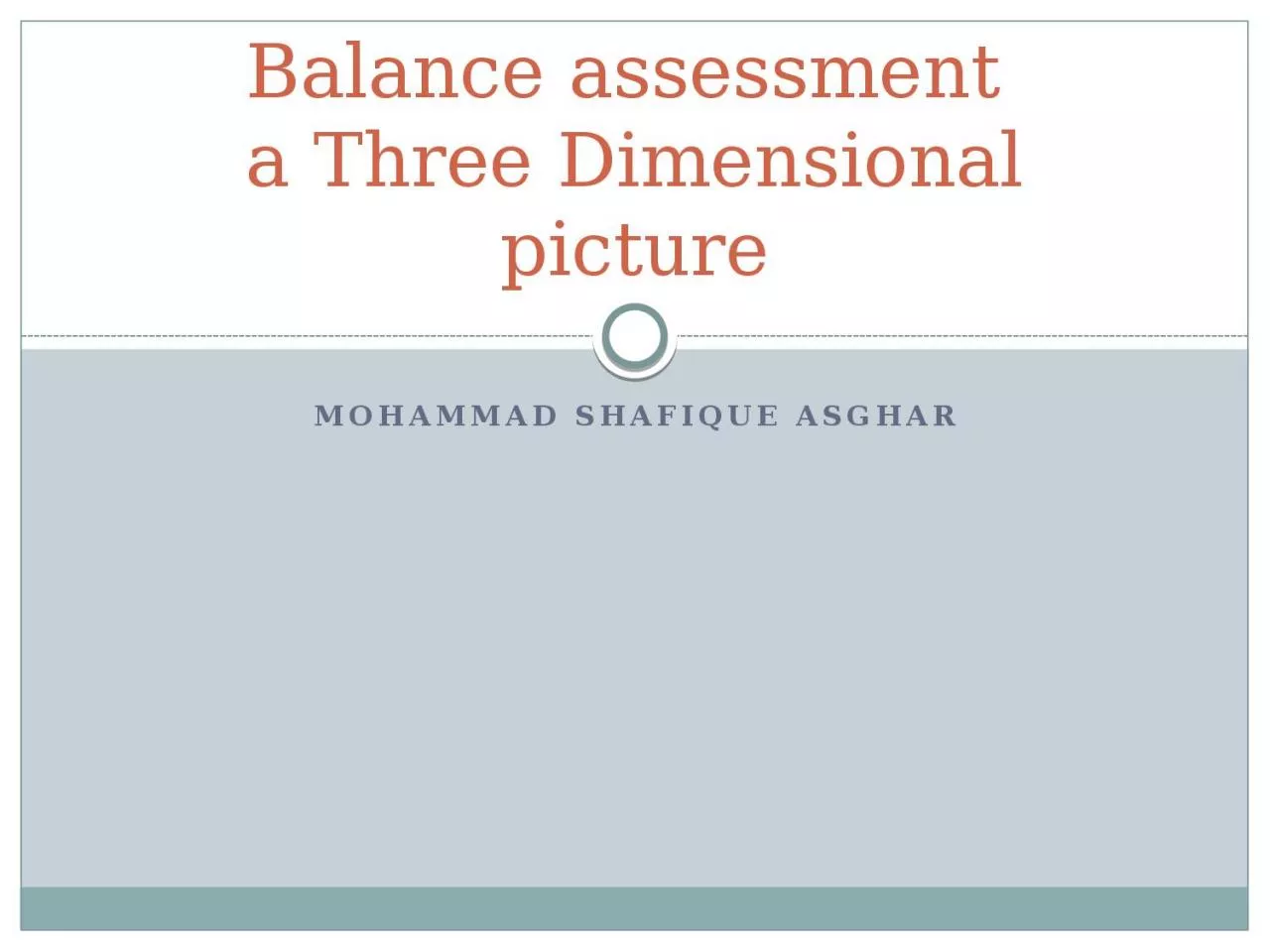

Balance assessment a Three Dimensional picture Three pillars Sensory Part Motor part Functional part Sensory Part Vision Somatosensory Vestibular system Central partintegration Vestibular ID: 935072
Download Presentation The PPT/PDF document "Mohammad Shafique AsghAR" is the property of its rightful owner. Permission is granted to download and print the materials on this web site for personal, non-commercial use only, and to display it on your personal computer provided you do not modify the materials and that you retain all copyright notices contained in the materials. By downloading content from our website, you accept the terms of this agreement.
Slide1
Mohammad Shafique AsghAR
Balance assessment
a Three Dimensional picture
Slide2Slide3Three pillars
Sensory
Part
Motor part
Functional part
Slide4Sensory Part
Vision
Somatosensory
Vestibular system
Slide5Central part/integration
Vestibular
neucleus
Brainstem, Cerebellum
Higher centres
Slide6Motor Part
VOR
(
vestibulo
occular
reflex)
VCR (
Vestibulocolic
Reflex)
VSR (
Vestibulospinal
reflex)
Slide7Central Integration
Slide8Functional Aspect Effective utilization of the available senses and adopt a strategy to be upright.
Motor control test (MOT): Looks at sequential spinal and long loop responses and coordination of ankle thigh and lower trunk muscles.
Sensory organization test (SOT): Looks at patients performance in progressively more difficult situations.
Slide9Slide10ENG abnormalities and suspected site of lesion
Test
Type of abnormality
Suspected site of lesion.
Saccade
Ipsilateral dysmetria
Bilateral dysmetria
Decreased velocity
Internuclear opthalmoplegia
Cerebellopontine angle
Cerebellum
Throughout the CNS, Muscle weakness or peripheral nerve palsy.
Medial longitudinal fasciculus
Pursuit
Breakup
Saccade
Brainstem or cerebellum
Cerebellum
Slide11ENG abnormalities and suspected site of lesion
Test
Type of abnormality
Suspected site of lesion
Gaze
Direction fixed and horizontal
Direction changing and vertical
Upbeating
Downbeating
Rotary
Peripheral vestibular
Brainstem
Brainstem or cerebellum
Cervico medullary junction or cerebellum
Vestibular nuclei/brainstem
FFS
Less than 40% decrease
Brainstem or cerebellum
Slide12ENG abnormalities and suspected site of lesion
Test
Type of Abnormality
Suspected site of lesion
Positional
Direction fixed
Direction changing
Nonlocalizing or peripheral
Nonlocalizing or central
Dix Hallpike
Classic
Peripheral vestibular –undermost ear
Caloric
Unilateral or bilateral weakness
Directional
Peripheral vestibular
Nonlocalizing
Preponderance
Slide13VIII N
Cochlear N
Vestibular N
PTA
ABR
Ecoch.G
Sup. Vest. N
Inf. Vest. N
Ant.SCC
Baseline thresholds
Shape
of audiogram
Retrocochlear pathology/
VEMP may add credibility
MD/EH
Drop attacks
Lat.SCC
Utricle
Post.SCC
Saccule
VAT/Positioning/
vHIT
Caloric/
Posiit
/Rot
Chair/
vHIT
VAT/Positioning/
vHIT
cVEMP
PTA
ABR
Ecoch.G
VEMP
VAT/
vHIT
ENG
oVEMP
VAT
ENG
VEMP
Dizzy battery
PTA
ABR
Ecoch.G
ENG
Rotary
Chair
VAT
oVEMP
cVEMP
vHIT
Flow chart
oVEMP
Slide14Vestibular Disorder .
Total number
Abnormal
number
Normal
number
Meniere’s disease
(Endolymphatic hydrops)
320
158
162
Vestibular
schwannoma
306
238
68
SSCD
64
64
0
Tullio phenomenon
13
12
1
Vestibular neuritis/
Labyrinthitis
99
49
50
Sensorineural HL
46
4
42
Multiple sclerosis
167
101
66
VEMP: literature Review (1994-2006)*
Slide15Slide16ENG abnormalities and suspected site of lesion
Test
Type of abnormality
Suspected site of lesion.
Saccade
Ipsilateral dysmetria
Bilateral dysmetria
Decreased velocity
Internuclear opthalmoplegia
Cerebellopontine angle
Cerebellum
Throughout the CNS, Muscle weakness or peripheral nerve palsy.
Medial longitudinal fasciculus
Pursuit
Breakup
Saccade
Brainstem or cerebellum
Cerebellum
Slide17ENG abnormalities and suspected site of lesion
Test
Type of abnormality
Suspected site of lesion
Gaze
Direction fixed and horizontal
Direction changing and vertical
Upbeating
Downbeating
Rotary
Peripheral vestibular
Brainstem
Brainstem or cerebellum
Cervico medullary junction or cerebellum
Vestibular nuclei/brainstem
FFS
Less than 40% decrease
Brainstem or cerebellum
Slide18ENG abnormalities and suspected site of lesion
Test
Type of Abnormality
Suspected site of lesion
Positional
Direction fixed
Direction changing
Nonlocalizing or peripheral
Nonlocalizing or central
Dix Hallpike
Classic
Peripheral vestibular –undermost ear
Caloric
Unilateral or bilateral weakness
Directional Preponderance
Peripheral vestibular
Nonlocalizing
Slide19SPINNED
S
udden (Onset)
Yes
Slow, gradual
P
ositional
Yes
No
I
ntensity
Severe
Ill defined
N
ausea/Diaphoresis
Frequent
Infrequent
N
ystagmus
Torsional/horizontal
Vertical
E
ar (hearing loss)
Can be present
Absent
D
uration
Paroxysmal
Constant
CNS signs
Absent
Usually present
PERIPHERAL
CENTRAL
Carvalho et al.
CTU
, Oct, 2004